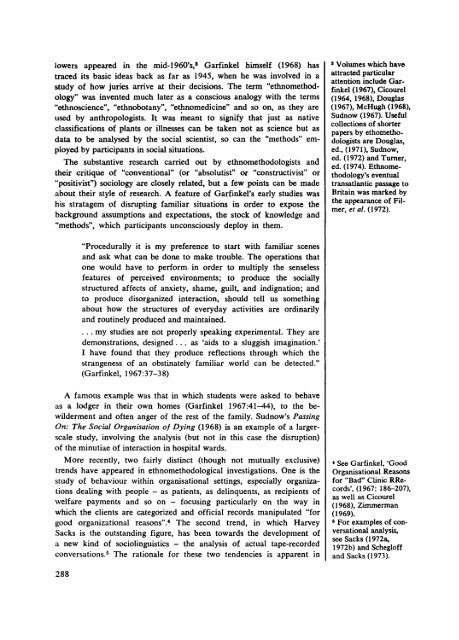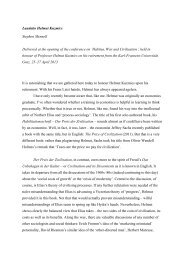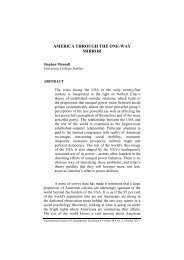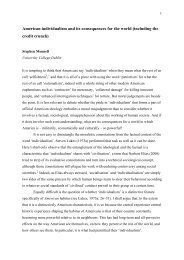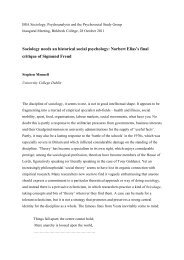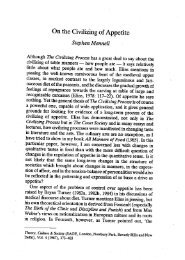Ethnomethodology and the New "Methodenstreit" - Stephen Mennell
Ethnomethodology and the New "Methodenstreit" - Stephen Mennell
Ethnomethodology and the New "Methodenstreit" - Stephen Mennell
You also want an ePaper? Increase the reach of your titles
YUMPU automatically turns print PDFs into web optimized ePapers that Google loves.
lowers appeared in <strong>the</strong> mid-1960's,3 Garfinkel himself (1968) hastraced its basic ideas back as far as 1945, when he was involved in astudy of how juries arrive at <strong>the</strong>ir decisions. The term "ethnomethodology"was invented much later as a conscious analogy with <strong>the</strong> terms"ethnoscience","ethnobotany", "ethnomedicine" <strong>and</strong> so on, as <strong>the</strong>y areused by anthropologists. It was meant to signify that just as nativeclassifications of plants or illnesses can be taken not as science but asdata to be analysed by <strong>the</strong> social scientist, so can <strong>the</strong> "methods" employedby participants in social situations.The substantive research carried out by ethnomethodologists <strong>and</strong><strong>the</strong>ir critique of "conventional"(or "absolutist" or "constructivist" or"positivist") sociology are closely related, but a few points can be madeabout <strong>the</strong>ir style of research. A feature of Garfinkel's early studies washis stratagem of disrupting familiar situations in order to expose <strong>the</strong>background assumptions <strong>and</strong> expectations, <strong>the</strong> stock of knowledge <strong>and</strong>"methods", which participants unconsciously deploy in <strong>the</strong>m."Procedurally it is my preference to start with familiar scenes<strong>and</strong> ask what can be done to make trouble. The operations thatone would have to perform, in order to multiply <strong>the</strong> senselessfeatures of perceived environments; to produce <strong>the</strong> sociallystructured affects of anxiety, shame, guilt, <strong>and</strong> indignation; <strong>and</strong>to produce disorganized interaction, should tell us somethingabout how <strong>the</strong> structures of everyday activities are ordinarily<strong>and</strong> routinely produced <strong>and</strong> maintained.... my studies are not properly speaking experimental. They aredemonstrations, designed... as 'aids to a sluggish imagination.'I have found that <strong>the</strong>y produce reflections through which <strong>the</strong>strangeness of an obstinately familiar world can be detected."(Garfinkel, 1967:37-38)3Volumes which haveattracted particularattention include Garfinkel(1967), Cicourel(1964, 1968), Douglas(1967), McHugh (1968),Sudnow (1967). Usefulcollections of shorterpapers by ethomethodologistsare Douglas,ed., (1971), Sudnow,ed. (1972) <strong>and</strong> Turner,ed. (1974). <strong>Ethnomethodology</strong>'seventualtransatlantic passage toBritain was marked by<strong>the</strong> appearance of Filmer,et al. (1972).A famous example was that in which students were asked to behaveas a lodger in <strong>the</strong>ir own homes (Garfinkel 1967:41-44), to <strong>the</strong> bewilderment<strong>and</strong> often anger of <strong>the</strong> rest of <strong>the</strong> family. Sudnow's PassingOn: The Social Organisation of Dying (1968) is an example of a largerscalestudy, involving <strong>the</strong> analysis (but not in this case <strong>the</strong> disruption)of <strong>the</strong> minutiae of interaction in hospital wards.More recently, two fairly distinct (though not mutually exclusive)trends have appeared in ethnomethodological investigations. One is <strong>the</strong>study of behaviour within organisational settings, especially organizationsdealing with people - as patients, as delinquents, as recipients ofwelfare payments <strong>and</strong> so on - focusing particularly on <strong>the</strong> way inwhich <strong>the</strong> clients are categorized <strong>and</strong> official records manipulated "forgood organizational reasons".' The second trend, in which HarveySacks is <strong>the</strong> outst<strong>and</strong>ing figure, has been towards <strong>the</strong> development ofa new kind of sociolinguistics - <strong>the</strong> analysis of actual tape-recordedconversations.5 The rationale for <strong>the</strong>se two tendencies is apparent in4 See Garfinkel, 'GoodOrganisational Reasonsfor "Bad" Clinic RRecords',(1967: 186-207),as well as Cicourel(1968), Zimmerman(1969).5 For examples of conversationalanalysis,see Sacks (1972a,1972b) <strong>and</strong> Schegloff<strong>and</strong> Sacks (1973).288


